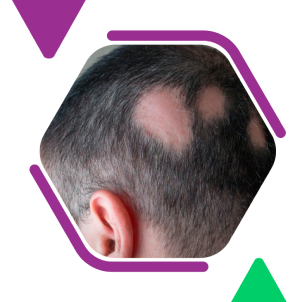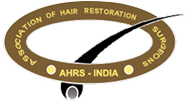- Home
- About Us
- Hair Treatment
- Hair Transplant
- Hair Loss
- Causes of Hair Loss
- Clinical Features
- Laboratory Test
- Medical Treatment
- Cyclic Treatment
- PRP
- Laser Treatment
- Surgical Treatment
- FUE
- Robotic
- FUT
- Beard Reconstruction
- Moustache Reconstruction
- Eyebrow Reconstruction
- Side Burn Reconstruction
- Complications Of Hair Transplant
- Alopecia Areata
- Telogen Effluvium
- Cosmetic Surgery
- Plastic Surgery
- Gallery
- Blogs
- Contact Us
Alopecia Areata

Alopecia Areata (AA) is a prevalent, often patchy, non-scarring hair loss condition that can impact any hair-bearing area of the body. Affecting approximately 1.7% of the global population, Alopecia Areata shows no gender preference, striking both males and females equally. It can occur suddenly, presenting as one or more round or oval patches of complete hair loss, which may expand and merge over time. While it can affect people of all ages, it is notably more common in children, with around 20% of affected individuals experiencing their first patch of hair loss before the age of 20. In some cases, Alopecia Areata may progress to Alopecia Totalis (complete loss of scalp hair) or Alopecia Universalis (complete loss of body hair).
Despite its unpredictable nature, many people with Alopecia Areata experience spontaneous regrowth of hair, although the condition can recur. The psychological impact of Alopecia Areata can be significant, leading to decreased self-esteem and emotional distress, emphasizing the importance of supportive care and counseling for affected individuals.
Causes:
The exact cause of Alopecia Areata remains unknown, but it is believed to arise from a complex interaction of genetic and environmental factors. Several potential triggers and associated conditions include stress, which has been implicated as a potential trigger for Alopecia Areata; infectious agents such as those caused by Cytomegalovirus, which may contribute to the onset of Alopecia Areata; and vaccinations, although this is relatively rare.
Hormonal factors and imbalances may also play a role in the development of Alopecia Areata, and a positive family history of Alopecia Areata is common, with several genes (e.g., CTLA4, ULBP3/6, IL2/21, and IL2RA) identified as being associated with the condition. Autoimmunity is a central aspect of Alopecia Areata’s pathogenesis, characterized by T cell-mediated attacks on hair follicles, making it an organ-specific autoimmune condition.
Differential Diagnosis:
When diagnosing Alopecia Areata, it is essential to differentiate it from other conditions that cause hair loss, such as androgenic alopecia, a common form of hair loss in both men and women, typically associated with aging and hormonal changes; telogen effluvium, a temporary form of hair loss often triggered by stress, illness, or hormonal changes; trichotillomania, a psychological condition characterized by the compulsive pulling out of one’s hair; and syphilitic alopecia, hair loss associated with syphilis infection, which can mimic Alopecia Areata.
Clinical Features:
Alopecia Areata typically presents with the sudden onset of hair loss and significant hair shedding. The characteristic lesions are oval or round, completely bald, and smooth patches that can appear on the scalp or any other hair-bearing area of the body. The scalp and beard are the most frequently affected areas. The patches may exhibit a mild peachy or pinkish-red coloration. Additionally, nail dystrophy, which involves changes to the nail’s texture and appearance, may be associated with Alopecia Areata.
Laboratory Tests:
To aid in diagnosing Alopecia Areata and identifying any underlying conditions, several laboratory tests may be conducted:
– Thyroid function test: To check for thyroid disorders, which can be associated with Alopecia Areata.
– Tests for ferritin, Vitamin-D, B12, Selenium, Zinc, and Copper: Deficiencies in these nutrients can contribute to hair loss and may be relevant in the context of Alopecia Areata.
Treatment:
Corticosteroids are a mainstay in the treatment of Alopecia Areata due to their immunosuppressive properties. Intralesional corticosteroids are considered the first-line therapy for adult patients with less than 50% scalp involvement. For circumscribed lesions, triamcinolone acetonide is the drug of choice. A 5 mg/mL solution, with a maximum of 3 mL, is injected intralesionally using a 30-gauge needle. Initial hair regrowth is often observed within 4 to 8 weeks, and treatments are repeated every 4 to 6 weeks. The main side effect is atrophy of the scalp. This treatment is generally not recommended for children under 10 years old. If no response is seen after 6 months, the treatment should be discontinued.
Topical corticosteroids, such as 0.05% betamethasone dipropionate cream, 0.05% clobetasol propionate, and 0.2% fluocinolone acetonide cream, can be used to promote hair growth. Primary complications from steroid use include skin atrophy, telangiectasia, and folliculitis, which are reversible upon cessation of treatment. The risk of adrenal suppression with topical steroids is minimal, but it should be monitored.
Oral corticosteroids, such as prednisone, can be effective in active, extensive Alopecia Areata. Prednisone is usually administered at a dose of 0.8 mg/kg in a tapering regimen over 6 weeks. Methylprednisolone injections may also be used for extensive and recent Alopecia Areata. Side effects of steroids include weight gain, osteoporosis, hypertension, psychological changes, suppression of the adrenal cortical axis, striae, acne, hypertrichosis, and purpura.
Topical Sensitizers:
Diphencyprone (DPCP) is the most commonly used topical sensitizer for Alopecia Areata. Sensitization typically begins with a 2% solution applied over a two-week period. Results may take up to two years to become evident. Side effects of DPCP include vesicular or bullous reactions, dissemination of allergic dermatitis, urticaria, enlargement of retroauricular lymph nodes, and altered skin pigmentation.
Minoxidil: Topical and Oral
Topical minoxidil, particularly in a 2% solution, has been reported to induce acceptable hair regrowth in patients with patchy Alopecia Areata. The precise mechanism by which minoxidil promotes hair growth in Alopecia Areata is not fully understood, but it is believed to involve the stimulation of hair follicles and the prolongation of the anagen (growth) phase of the hair cycle.
Light Therapy:
Psoralene combined with ultraviolet A (PUVA) therapy can be used to treat patchy Alopecia Areata. PUVA involves the use of a photosensitizing agent (psoralen) followed by exposure to UVA light. This treatment can help stimulate hair regrowth, although its effectiveness varies among individuals.
Anthralin:
Anthralin, a topical medication originally used to treat psoriasis, can also be used to manage Alopecia Areata. It is believed to work by modulating the immune response and reducing inflammation around the hair follicles. Treatment with anthralin should be initiated with low concentrations to minimize skin irritation and gradually increased as tolerated.
Biologics:
Currently, biologic agents are not recommended for the treatment of Alopecia Areata. Biologics are typically used to treat other autoimmune conditions, but their efficacy in Alopecia Areata has not been well established.
Combination Therapy:
Combination therapy, which often involves the use of a topical steroid and minoxidil, is commonly employed in the treatment of Alopecia Areata and has shown promising results. This approach aims to maximize hair regrowth by utilizing the synergistic effects of both medications.
Complications of Treatment:
While treatment options for Alopecia Areata can be effective, they also come with potential complications and side effects. It’s important for patients to be aware of these and to discuss them with their healthcare provider. The use of corticosteroids, particularly intralesional and oral forms, carries several risks. Skin atrophy, telangiectasia, and folliculitis are common local side effects of topical and intralesional corticosteroids. Systemic side effects of oral corticosteroids include weight gain, osteoporosis, hypertension, psychological changes, suppression of the adrenal cortical axis, striae, acne, hypertrichosis, and purpura. These side effects are often dose-dependent and can be managed by careful monitoring and dose adjustments.
Topical sensitizers like DPCP can cause allergic reactions, including vesicular or bullous reactions, dissemination of allergic dermatitis, urticaria, enlargement of retroauricular lymph nodes, and altered skin pigmentation. These side effects can be distressing for patients and may require discontinuation of treatment if severe. The use of minoxidil can lead to side effects such as scalp irritation, itching, and unwanted facial hair growth. Oral minoxidil, while less commonly used, can cause systemic side effects like hypotension and fluid retention.
PUVA therapy can cause side effects such as nausea, itching, and increased risk of skin cancer with long-term use. Patients undergoing PUVA therapy should be monitored for these potential complications. Anthralin can cause skin irritation, staining of the skin and clothing, and temporary hair discoloration. Patients should be educated on proper application techniques to minimize these side effects.
Psychological Impact:
Alopecia Areata can have a significant psychological impact on patients due to its visible nature and the potential for social stigma. Hair loss can lead to decreased self-esteem, anxiety, depression, and social withdrawal. It is important for healthcare providers to address the psychological aspects of Alopecia Areata and provide support or referrals to mental health professionals as needed.
Prognosis:
The prognosis for Alopecia Areata varies widely among individuals. Some patients experience spontaneous regrowth of hair within a year, while others may have recurrent episodes of hair loss. The severity and extent of hair loss, as well as the patient’s response to treatment, can influence the long-term outlook.
Our Services
- Hair Loss
- Causes of Hair Loss
- Clinical Features
- Laboratory Test
- Medical Treatment
- Cyclic Treatment
- PRP
- Hair Transplant
- Surgical Treatment
- FUE
- FUT
- Beard Reconstruction
- Moustache Reconstruction
- Eyebrow Reconstruction
- Side Burn Reconstruction
- Complications of Hair Transplant
- Alopecia Areata
- Telogen Effluvium
- Laser Treatment



 Book an Appointment
Book an Appointment